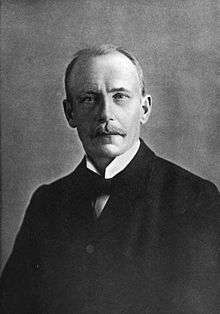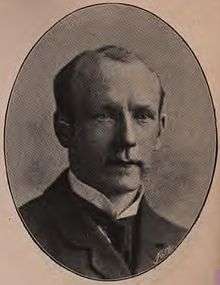Sydney Buxton, 1st Earl Buxton
| The Right Honourable The Earl Buxton GCMG PC | |
|---|---|
 | |
| Postmaster General | |
|
In office 1905–1910 | |
| Monarch | Edward VII |
| Prime Minister |
Sir Henry Campbell-Bannerman H.H. Asquith |
| Preceded by | The Lord Stanley |
| Succeeded by | Herbert Samuel |
| President of the Board of Trade | |
|
In office 14 February 1910 – 11 February 1914 | |
| Monarch |
Edward VII George V |
| Prime Minister | H.H. Asquith |
| Preceded by | Winston Churchill |
| Succeeded by | John Burns |
| 2nd Governor-General of the Union of South Africa | |
|
In office 1914–1920 | |
| Monarch | George V |
| Prime Minister |
H.H. Asquith David Lloyd George |
| Preceded by | The Viscount Gladstone |
| Succeeded by | HRH Prince Arthur of Connaught |
| Personal details | |
| Born |
25 October 1853 London, England, UK |
| Died |
15 October 1934 (aged 80) Newtimber, West Sussex, England, UK |
| Nationality | British |
| Political party | Liberal |
| Spouse(s) |
Constance Mary Lubbock (1882–1892; her death); 3 children Mildred Anne Smith (1896–1934; his death); 3 children |
| Alma mater | Trinity College, Cambridge |
| Profession | Member of Parliament |


Sydney Charles Buxton, 1st Earl Buxton GCMG PC (25 October 1853 – 15 October 1934) was a radical British Liberal politician of the late 19th and early 20th centuries.[1][2]
Background and education
Buxton was the son of Charles Buxton and grandson of social reformer Sir Thomas Fowell Buxton, 1st Baronet. His mother was Emily Mary, daughter of the physician and traveller Sir Henry Holland, 1st Baronet. He was born in London and educated at Clifton College and Trinity College, Cambridge,[3] and was a member of the London School Board from 1876 to 1882.
Political career
In 1880, Buxton became prominent in political circles by the publication of his Handbook to the Political Questions of the Day, a work which eventually went through 11 editions. That same year, he ran for Parliament for Boston, but lost. However, he became an MP in 1883 by winning a by-election in Peterborough. He was defeated in the 1885 general election, but returned to Parliament the very next year, representing Poplar. He would represent this constituency in Parliament until 1914.[1]
From 1892-95, Buxton served as Under-Secretary of State for the Colonies. In 1905, he earned his first Cabinet post, that of Postmaster-General. In this capacity he introduced such services as penny postage to the United States, the Canadian magazine post, and cheap postage for the blind. In 1910, Buxton was named President of the Board of Trade; in this position he oversaw the passage or amendment of many trade and commerce laws. Upon the sinking of the RMS Titanic in 1912, he asked Lord Loreburn, the Lord Chancellor, to appoint a commission of inquiry into the disaster. This commission eventually came to be headed by Lord Mersey.[1]
In February 1914, Buxton was appointed Governor-General of South Africa, and in May of that year he was raised to the peerage as Viscount Buxton, of Newtimber in the County of Sussex. A revolt by the South African populace on the outbreak of the First World War temporarily threatened his safety, but the country's Prime Minister, General Louis Botha, immediately attached South Africa to Britain. Thereafter, Buxton and Botha formed an effective partnership, planning and executing South African actions in the war, including the invasion of the neighbouring German colony of South West Africa. Buxton travelled widely throughout South Africa, and endeared himself to the people. Upon his retirement in 1920, the people demonstrated their affection for him. He continued his interest in South African affairs after returning to England, serving as president of the African Society from 1920-33.
He was created Earl Buxton in 1920, and continued to be a member of the Liberal Party, often supporting his close friend and colleague Sir Edward Grey. In his later years, he had to undergo amputation of his leg due to a knee injury sustained earlier in his life.
He died at Newtimber on 15 October 1934.[1]
Marriages
Buxton was twice married, firstly in 1882 to Hon. Constance Mary Lubbock (died 1892), second daughter of Lord Avebury, and secondly in 1896 to Mildred Anne Smith, elder daughter of Hugh Colin Smith, Governor of the Bank of England, of Mount Clare, Roehampton, a sister of the banker Vivian Smith and of Aubrey Smith, RN, who later became an admiral.[1]
By his first wife, he had two sons and one daughter, of whom the sons both died in his lifetime. By his second wife, he had one son and two daughters, of whom the son and the elder daughter died in his lifetime.[1]
Issue
By his first wife Hon. Constance Mary Lubbock (d. 3 November 1892):
- Charles Sydney Buxton (26 May 1884 – 31 August 1911); died unmarried. The elder son Charles Sydney Buxton (1884–1911), the only surviving son by his first wife Constance, proposed marriage to Octavia Wilberforce (1888–1963), a descendant of the reformer, but she refused him.
- Kenneth Sydney Buxton (4 September 1886 – 27 August 1894); died in childhood, aged seven.
- Lady Phyllis Sydney Buxton (17 April 1888 – 27 January 1942), later Lady Phyllis Ponsonby OBE; married 23 September 1918 Rev. Canon Maurice George Jesser Ponsonby, MC, DL, JP (10 September 1880 – 27 February 1943), a grandson of the 2nd Baron De Mauley, had 5 children, of which two (Elizabeth and Mary) have descendants
By his second wife Mildred Anne Smith (d. 7 December 1955):
- Lady Doreen Maria Josepha Sydney Buxton (29 November 1897 – 28 July 1923), a fraternal twin; married 24 January 1918 Charles Alfred Euston Fitzroy, a scion of the dukes of Grafton. She died aged 25, shortly after the birth of her third child. After her death, her husband remarried. His second wife, Lucy Eleanor Barnes (died 1943), was a first cousin of his first wife through her Buxton mother, in 1924. Twice widowed, he married, thirdly, in 1944. He succeeded to the dukedom in 1936 when a young cousin, the 9th Duke of Grafton was killed in a motoring race.
- Hon. Denis Bertram Sydney Buxton (29 November 1897 – 9 October 1917), a fraternal twin; killed in action, aged 19, Passchendaele, France, as a Second Lieutenant in the Coldstream Guards. At the time of his death, he was his father's only surviving son and heir to his titles.
- Lady Alethea Constance Dorothy Sydney Buxton (2 August 1910 – 25 July 2004); married Venerable Peter Charles Eliot, TD, MBE (30 October 1910 – 1995), son of Hon. Edward Granville Eliot (himself grandson of the 3rd Earl of St Germans) and Clare Louise Phelips, on 12 July 1934. They had no issue, and Lady Alethea died aged 93 in 2004.
Since both his surviving sons died unmarried in his lifetime, his titles became extinct at his death. Earl Buxton was survived by his second wife Mildred (died 1955) and his youngest daughter Lady Althea Eliot (died 2004), and by eight grandchildren including the future Duke of Grafton (1919–2011).
References
- 1 2 3 4 5 6 "Earl 0f Buxton, 80, Is Dead In England. Liberal Was Member of Last Gladstone Government and Long in Parliament. Held South African Post. As Governor, Dealt With Revolt of Boers. Introduced Penny Post for United States". New York Times. October 16, 1934.
- ↑ Profile, books.google.co.uk; accessed 8 April 2016.
- ↑ "Buxton, Sydney (BKSN872SC)". A Cambridge Alumni Database. University of Cambridge.
External links
- Hansard 1803–2005: contributions in Parliament by Sydney Buxton
- Titanic's Supreme Survivor – Sydney Buxton
- Buxton genealogy
| Parliament of the United Kingdom | ||
|---|---|---|
| Preceded by Hampden Whalley Hon. John Wentworth-FitzWilliam |
Member of Parliament for Peterborough 1883–1885 With: Hon. John Wentworth-FitzWilliam |
Succeeded by John Wentworth-FitzWilliam |
| Preceded by Henry Green |
Member of Parliament for Poplar 1886–1914 |
Succeeded by Alfred William Yeo |
| Political offices | ||
| Preceded by Baron Henry de Worms |
Under-Secretary of State for the Colonies 1892–1895 |
Succeeded by The Earl of Selborne |
| Preceded by Lord Stanley |
Postmaster General 1905–1910 |
Succeeded by Herbert Samuel |
| Preceded by Winston Churchill |
President of the Board of Trade 1910–1914 |
Succeeded by John Burns |
| Preceded by The Viscount Gladstone |
Governor-General of South Africa 1914–1920 |
Succeeded by HRH Prince Arthur of Connaught |
| Peerage of the United Kingdom | ||
| New creation | Earl Buxton 1920–1934 |
Extinct |
| New creation | Viscount Buxton 1914–1934 | |
.svg.png)
.svg.png)